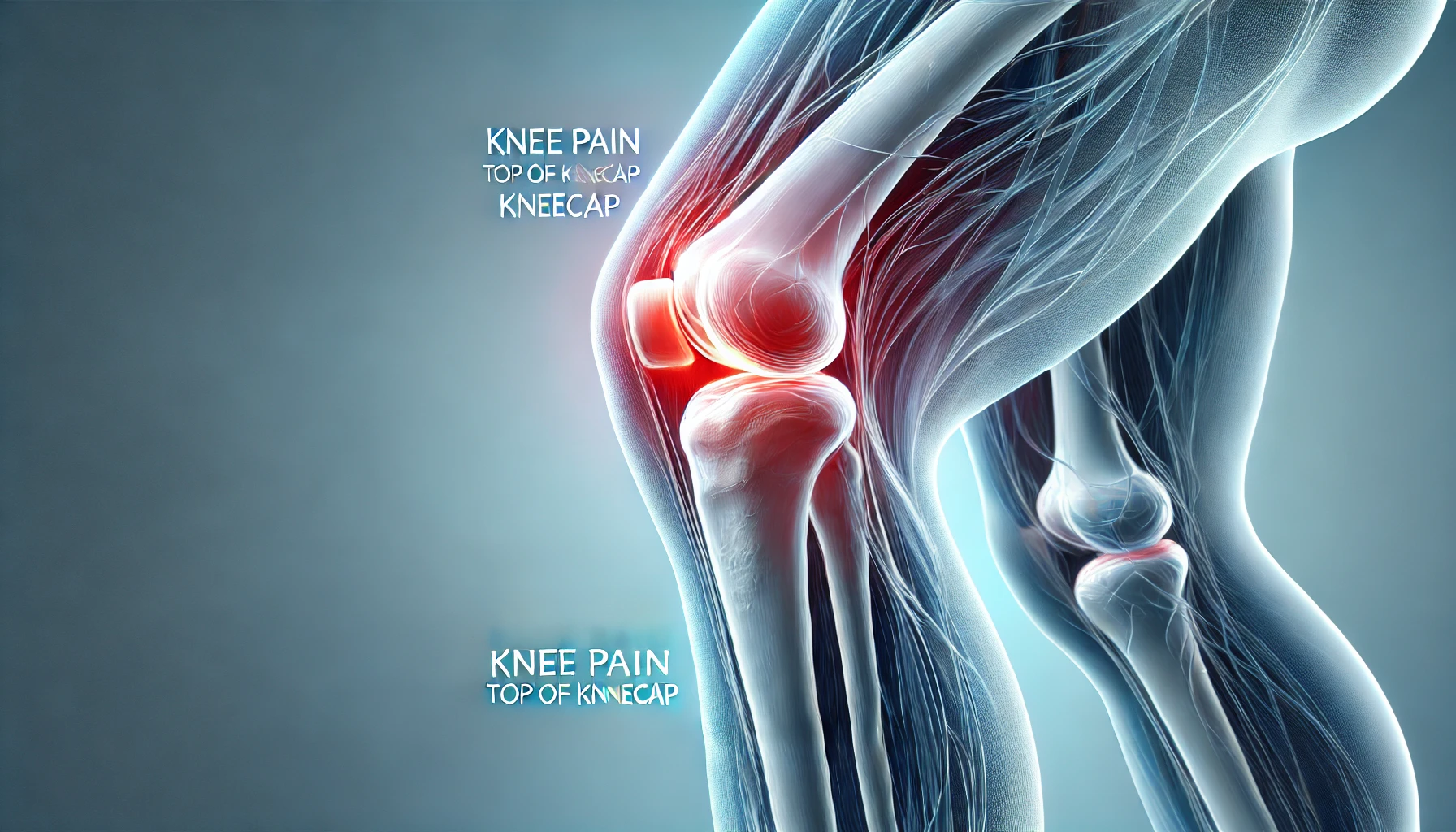If you’re experiencing knee pain at the top of your kneecap, you’re not alone. Many people deal with discomfort in this area, especially athletes, runners, and those with physically demanding jobs. This type of pain can range from mild discomfort to severe, affecting your ability to walk, climb stairs, or even sit comfortably.
In this article, I’ll explain the common causes of knee pain at the top of the kneecap, how to treat it effectively, and what steps you can take to prevent it from happening again.
Common Causes of Knee Pain at the Top of the Kneecap

Pain at the top of the kneecap is often linked to overuse, injury, or underlying medical conditions. Here are the most common reasons you might be experiencing this discomfort:
1. Quadriceps Tendonitis
This is one of the most frequent causes of pain at the top of the kneecap. It occurs when the quadriceps tendon (which connects the thigh muscles to the kneecap) becomes inflamed due to overuse or strain.
Symptoms:
✔️ Pain and tenderness just above the kneecap
✔️ Swelling in the front of the knee
✔️ Stiffness or discomfort when extending the knee
Causes:
- Repetitive jumping, running, or squatting
- Sudden increase in physical activity
- Weak quadriceps muscles
2. Patellofemoral Pain Syndrome (Runner’s Knee)
Patellofemoral pain syndrome occurs when the kneecap doesn’t move smoothly in its groove, leading to pain around and above the kneecap.
Symptoms:
✔️ Dull, aching pain at the front of the knee
✔️ Pain that worsens with activity (running, squatting, or climbing stairs)
✔️ A cracking or grinding sensation in the knee
Causes:
- Poor knee alignment
- Weak thigh muscles
- Overuse or repetitive stress
3. Bursitis (Prepatellar Bursitis)
Bursitis happens when the bursa (a small fluid-filled sac above the kneecap) becomes inflamed due to excessive kneeling or repetitive pressure.
Symptoms:
✔️ Swelling and warmth above the kneecap
✔️ Pain when bending or straightening the knee
✔️ Redness and tenderness
Causes:
- Frequent kneeling (common in construction workers and athletes)
- Direct impact or trauma to the knee
- Infection (in rare cases)
4. Osteoarthritis of the Knee
Osteoarthritis is a degenerative condition that causes the knee cartilage to wear down over time, leading to pain and stiffness.
Symptoms:
✔️ Gradual onset of pain above the kneecap
✔️ Swelling and stiffness, especially in the morning
✔️ Pain that worsens with activity and improves with rest
Causes:
- Aging and wear-and-tear on the knee joint
- Previous knee injuries
- Excess weight adding stress to the knee
5. Muscle Imbalance or Weakness
Weak quadriceps or hamstrings can lead to poor knee alignment, increasing stress on the top of the kneecap. Strength imbalances can cause improper kneecap tracking, leading to pain and discomfort.
Symptoms:
✔️ Aching pain when climbing stairs
✔️ Knee instability or a feeling of “giving out”
✔️ Discomfort after long periods of sitting
Causes:
- Weak quadriceps or hamstrings
- Poor flexibility
- Improper movement patterns
How to Treat Knee Pain at the Top of the Kneecap
The right treatment depends on the cause of your pain, but non-surgical methods are often very effective in relieving discomfort.
1. Rest and Activity Modification
If your knee pain is caused by overuse or repetitive stress, resting the joint is crucial. Avoid high-impact activities like running or jumping until your knee feels better.
2. Ice and Heat Therapy
- Ice therapy (15-20 minutes every few hours) helps reduce swelling and numb pain.
- Heat therapy can be useful for stiffness and muscle relaxation.
3. Physical Therapy and Strengthening Exercises
Building strong and flexible leg muscles reduces stress on the kneecap. Here are some helpful exercises:
✔️ Straight Leg Raises: Strengthen the quadriceps without putting pressure on the knee.
✔️ Quadriceps Stretch: Helps improve flexibility and knee alignment.
✔️ Glute Bridges: Strengthen the hips and hamstrings, which support knee stability.
✔️ Wall Sits: Improve endurance in the thigh muscles to protect the knee joint.
4. Knee Braces and Supportive Gear
Wearing a knee brace or supportive taping can help reduce pain by stabilizing the kneecap and preventing excessive movement.
5. Pain Medications
Over-the-counter pain relievers like ibuprofen (Advil) or naproxen (Aleve) can help reduce inflammation and discomfort. However, these should only be used as needed and not as a long-term solution.
Also Read: Knee Arthritis Treatment Without Surgery – Effective Ways to Relieve Pain!
6. Avoid Prolonged Kneeling
If your pain is due to bursitis, minimize activities that put direct pressure on the kneecap. Consider using knee pads if your job requires frequent kneeling.
How to Prevent Knee Pain at the Top of the Kneecap
Taking proactive steps can help prevent knee pain from returning.
1. Strengthen Your Leg Muscles
A well-balanced exercise routine focusing on quadriceps, hamstrings, and glutes will support your knee and prevent excess strain.
2. Maintain Proper Posture and Movement Patterns
✔️ Avoid excessive inward knee movement (knock knees) when squatting or climbing stairs.
✔️ Use proper footwear that provides good arch support and shock absorption.
3. Warm Up Before Exercise
Always stretch and warm up before intense physical activities to prepare your muscles and joints.
4. Maintain a Healthy Weight
Excess weight puts additional strain on the knees. Losing even a small amount of weight can significantly reduce knee pain.
5. Modify High-Impact Activities
If running or jumping worsens your pain, switch to low-impact exercises like swimming or cycling.
When to See a Doctor
If your knee pain:
❌ Persists for more than a few weeks despite home treatment
❌ Is accompanied by swelling, redness, or warmth
❌ Causes difficulty walking or bearing weight
❌ Was triggered by a sudden injury or fall
…it’s best to consult a doctor for a proper diagnosis and treatment plan.
FAQ’s
1. Why do I feel pain at the top of my kneecap when walking or climbing stairs?
Pain at the top of the kneecap while walking or climbing stairs is often due to quadriceps tendonitis, patellofemoral pain syndrome, or muscle weakness. These conditions cause strain on the kneecap, leading to discomfort during movement. Strengthening your quadriceps and using proper footwear can help reduce pain.
2. Can knee pain at the top of the kneecap go away on its own?
Mild cases of knee pain caused by overuse or strain may improve with rest, ice, and proper stretching. However, if the pain persists for more than a few weeks, worsens, or affects daily activities, it’s best to see a doctor for evaluation and treatment.
3. What exercises should I avoid if I have pain above my kneecap?
Avoid high-impact activities like running, deep squats, and jumping exercises if they worsen your pain. Instead, opt for low-impact exercises like swimming, cycling, and gentle strength training to support knee recovery.
4. How can I prevent knee pain at the top of my kneecap from coming back?
To prevent recurring knee pain, focus on strengthening your leg muscles, maintaining proper posture, using supportive footwear, and avoiding excessive kneeling or high-impact activities that strain the quadriceps tendon.
5. When should I see a doctor for knee pain at the top of the kneecap?
You should see a doctor if your knee pain persists for more than a few weeks, worsens despite home treatments, is accompanied by swelling, redness, or warmth, or if you experience difficulty walking or bearing weight on the affected leg.
Final Thoughts
Pain at the top of the kneecap can be frustrating, but most cases can be managed without surgery. By identifying the cause, using effective treatments like rest, strengthening exercises, and proper knee support, and taking preventive measures, you can keep your knees healthy and pain-free. If your symptoms persist or worsen, don’t ignore them—seeking medical advice early can help prevent long-term damage.
Related Post
- Zimatejigemo – Unlocking the Fusion of Creativity, Identity, and Innovation!
- Tinaypimatelate – The Revolutionary Concept Shaping the Future of Innovation!
- Limhuloxidpov – A Complete Guide to Understanding This Unique Concept!
- Zaxtexporoz – Exploring the Emerging Concept of Innovation and Digital Transformation!
- Lekulent – The Breakthrough Wellness Solution Taking the Health World by Storm!






